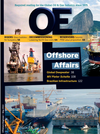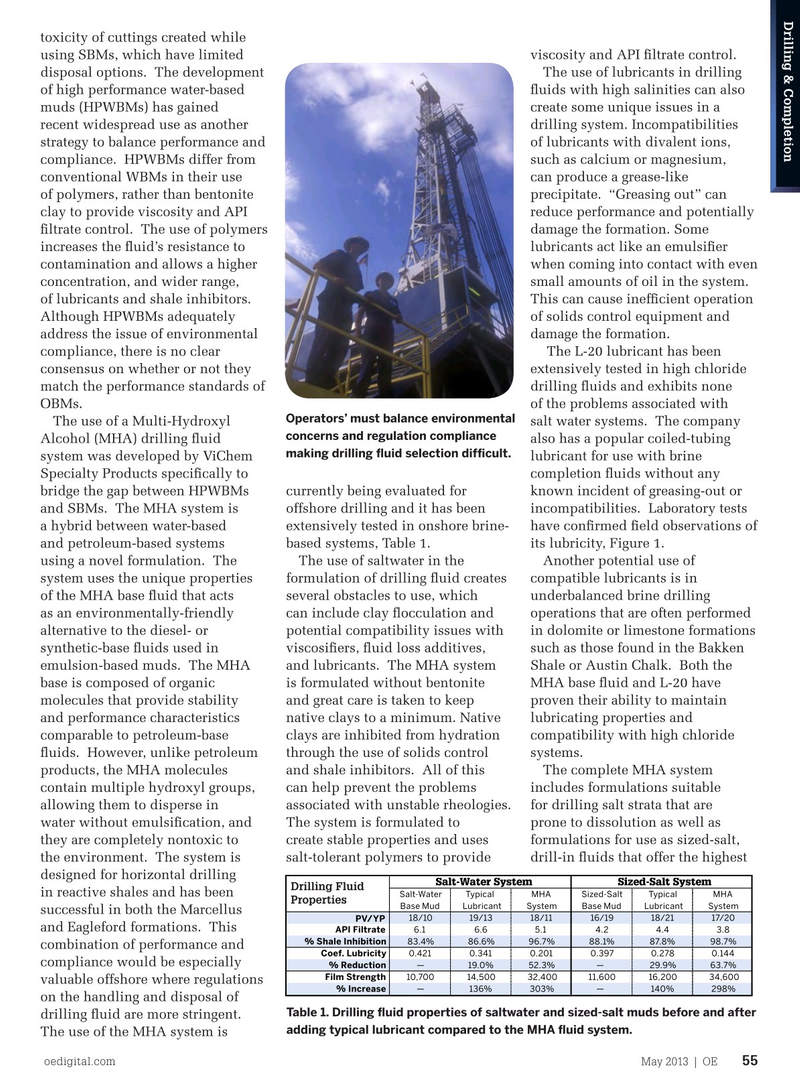
Page 53: of Offshore Engineer Magazine (May/Jun 2013)
Read this page in Pdf, Flash or Html5 edition of May/Jun 2013 Offshore Engineer Magazine
Drilling & Completion toxicity of cuttings created while using SBMs, which have limited viscosity and API fltrate control. disposal options. The development The use of lubricants in drilling of high performance water-based fuids with high salinities can also muds (HPWBMs) has gained create some unique issues in a recent widespread use as another drilling system. Incompatibilities strategy to balance performance and of lubricants with divalent ions, compliance. HPWBMs differ from such as calcium or magnesium, conventional WBMs in their use can produce a grease-like of polymers, rather than bentonite precipitate. “Greasing out” can clay to provide viscosity and API reduce performance and potentially fltrate control. The use of polymers damage the formation. Some increases the fuid’s resistance to lubricants act like an emulsifer contamination and allows a higher when coming into contact with even concentration, and wider range, small amounts of oil in the system. of lubricants and shale inhibitors. This can cause ineffcient operation
Although HPWBMs adequately of solids control equipment and address the issue of environmental damage the formation. compliance, there is no clear The L-20 lubricant has been consensus on whether or not they extensively tested in high chloride match the performance standards of drilling fuids and exhibits none
OBMs. of the problems associated with
Operators’ must balance environmental
The use of a Multi-Hydroxyl salt water systems. The company concerns and regulation compliance
Alcohol (MHA) drilling fuid also has a popular coiled-tubing making drilling fuid selection diffcult.
system was developed by ViChem lubricant for use with brine
Specialty Products specifcally to completion fuids without any bridge the gap between HPWBMs currently being evaluated for known incident of greasing-out or and SBMs. The MHA system is offshore drilling and it has been incompatibilities. Laboratory tests a hybrid between water-based extensively tested in onshore brine- have confrmed feld observations of and petroleum-based systems based systems, Table 1. its lubricity, Figure 1. using a novel formulation. The The use of saltwater in the Another potential use of system uses the unique properties formulation of drilling fuid creates compatible lubricants is in of the MHA base fuid that acts several obstacles to use, which underbalanced brine drilling as an environmentally-friendly can include clay focculation and operations that are often performed alternative to the diesel- or potential compatibility issues with in dolomite or limestone formations synthetic-base fuids used in viscosifers, fuid loss additives, such as those found in the Bakken emulsion-based muds. The MHA and lubricants. The MHA system Shale or Austin Chalk. Both the base is composed of organic is formulated without bentonite MHA base fuid and L-20 have molecules that provide stability and great care is taken to keep proven their ability to maintain and performance characteristics native clays to a minimum. Native lubricating properties and comparable to petroleum-base clays are inhibited from hydration compatibility with high chloride fuids. However, unlike petroleum through the use of solids control systems. products, the MHA molecules and shale inhibitors. All of this The complete MHA system contain multiple hydroxyl groups, can help prevent the problems includes formulations suitable allowing them to disperse in associated with unstable rheologies. for drilling salt strata that are water without emulsifcation, and The system is formulated to prone to dissolution as well as they are completely nontoxic to create stable properties and uses formulations for use as sized-salt, the environment. The system is salt-tolerant polymers to provide drill-in fuids that offer the highest designed for horizontal drilling
Salt-Water System Sized-Salt System
Drilling Fluid in reactive shales and has been
Salt-WaterTypical MHA Sized-SaltTypical MHA
Properties
Base Mud Lubricant System Base Mud Lubricant System successful in both the Marcellus 18/10 19/13 18/11 16/19 18/21 17/20
PV/YP and Eagleford formations. This
API Filtrate 6.1 6.6 5.1 4.2 4.4 3.8 % Shale Inhibition 83.4% 86.6% 96.7% 88.1% 87.8% 98.7% combination of performance and
Coef. Lubricity 0.421 0.341 0.201 0.397 0.278 0.144 compliance would be especially % Reduction — 19.0% 52.3% — 29.9%63.7%
Film Strength 10,700 14,500 32,400 11,600 16,200 34,600 valuable offshore where regulations — 136% 303% — 140% 298%% Increase on the handling and disposal of
Table 1. Drilling fuid properties of saltwater and sized-salt muds before and after drilling fuid are more stringent. adding typical lubricant compared to the MHA fuid system.
The use of the MHA system is oedigital.com May 2013 | OE 55
DC2 Fluids.indd 55 4/22/13 4:34 PM

 52
52

 54
54